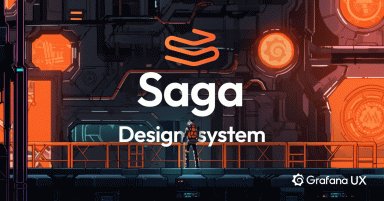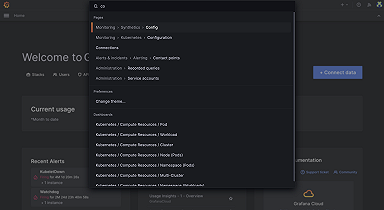
Working at Grafana Labs: What it's like to be a Product Designer
I’ve been working as a product designer for the past four years, and I’ve spent 1.5 of them here at Grafana Labs. As a product designer, I create and optimize for the user experience by taking in design principles, business goals, and user data. This includes designing how users flow through the features, how users interact with areas of the product, and what they see visually.
I love being a product designer because I truly enjoy talking to users, understanding their problems, and being creative when ideating through solutions. Working at Grafana has been rewarding because I’ve had the opportunity to collaborate with many smart, talented coworkers. And as a product designer, every day feels like solving a new puzzle!
What people outside my field may not realize is that my job can be tough — especially because I don’t have a technical background.
During my time here, I’ve had conversations with other UX coworkers who have lamented the challenges of working on engineering tools. Other friends in my field have mentioned that they avoid working on engineering tools altogether because of the upfront domain knowledge you need in order to know what the user needs.
Grafana is not just an engineering tool, but an engineering tool that very talented people built in a technically complex way. Occasionally, things have been more complicated for me because I haven’t always paired with a product manager to help bridge the gap between UX and Engineering. As a result, I may spend more time than average speaking with users, subject matter experts, and engineers to gather context on a feature and understand a problem.
Some things I’ll commonly bring up:
- “What does this feature do?”
- “The user talked about this challenge, but I don’t understand the use case.”
- “I just listened to this person talk about something for five minutes and barely understood a word.”
I’ve learned a lot over the past year about how to make product designing easier so I can solve problems — for users and myself! — and create effective solutions. These are three of my top tips:
1. Make allies inside and outside your company.
You may be thinking, “Isn’t building good relationships just the basics of being a good employee?”
Yes, but it’s not always something that comes quickly to everyone. And it’s also not enough to just build “good” relationships with your direct peers and fellow designers. Let me explain why.
Being a successful product designer means developing a good understanding of your domain. Great product designers devote time to becoming curious and questioning everything. But when you’re working on a product you know nothing about, you have to push that skill beyond your max. It can be challenging, especially if you struggle with a sense of “belonging” as a UXer in an engineering-driven environment.
Personally, I have always struggled with asking questions, especially when I need someone to start explaining something from ground zero. The idea of taking up someone else’s time so they can explain basic concepts is deeply uncomfortable. However, by building relationships with a wide range of people, I’ve been able to find the ones who are genuinely eager to help.
One trick to doing that? When you start at a company, get quick wins by shipping smaller projects — it helps people believe in you and trust your skills. Once you have stronger footing, you’ll feel more comfortable reaching out to public Slack channels if you need assistance with something.
Depending on the type of person you are, building bonds can take a bit of time, but in the meantime, speaking with knowledgeable friends outside the company also can be really helpful. It’s embarrassing how much I rely on my partner (a software engineer), who has kindly explained concepts such as containers and packages, debugged build errors, and helped me set up servers and agents. And don’t ignore ChatGPT — I’ve asked it to explain everything from PromQL queries to various TLS authentication types.
2. Share work often with subject manager experts (SMEs).
SMEs can include solutions engineers, internal power users, or people who have previously worked in the industry. They can be great resources if you’re a product designer who needs quick advice on how to understand problems, wants to gather feedback, or could use gut checks.
I went to SMEs when I was working on a redesign of Grafana’s transformations feature. Understanding what each transformation did was important to the redesign, so I took the time to read and use each transformation myself, then checked with experts to validate my thoughts. After that, I wanted to group the transformations together so users could perform a filter. I ran an informal grouping exercise and got additional feedback on the groupings afterwards. I ran through designs again with SMEs at various stages along the way.
At previous companies, when I couldn’t run a large-scale research study to go along with a redesign, I would informally share work with internal power users.
3. Collaborate with your engineers.
Product managers and UX designers can have great ideas, but when we’re working on an engineering tool, it’s important for us to remember that we don’t always have all the ideas. Ideally, you should bring your engineers into the ideation and design process whenever possible.
For almost every project I’ve worked on at Grafana, I’ve either workshopped or ideated with some engineers from kickoff in order to understand their problems and goals.
There are so many ways to go about bringing engineers into the process, formally or informally. I’ve had success with casual discussions, but when I was kicking off a Prometheus AI query assistant feature, I did it through a workshop I’d designed. We went through the user problems, and I empowered the engineers to come up with a set of goals, metrics, and an idea of what we were to build. Being able to collaborate and bounce around ideas together was useful when there was some ambiguity about the next steps.
When I’ve needed to work fast, I’ve done a lot of quick iterations and back-and-forth brainstorming with my front-end engineers. That process was very helpful when I was working through a challenging interaction redesign, and it helped us find a solution without delay. Even though we had to pivot from the initial ideas, UX and engineering were still able to be on the same page about the problems and how to fix them.
My big takeaway
As you hopefully can tell, all of my tips share a theme: communication. Through connecting, learning, and collaborating with my technical coworkers, I have been able to come up with better ideas and feel more confident in the work I ship. I’m not saying they’re the only thing that has helped me succeed in my role at Grafana, but they have taken me a long way in feeling less anxious.
Regardless of your role, I hope I’ve helped you learn a bit about what designing at Grafana has been like for me!
Learn more about the Grafana Labs team and our remote-first culture, and find out how you can become an official Grafanista by visiting our careers page.



